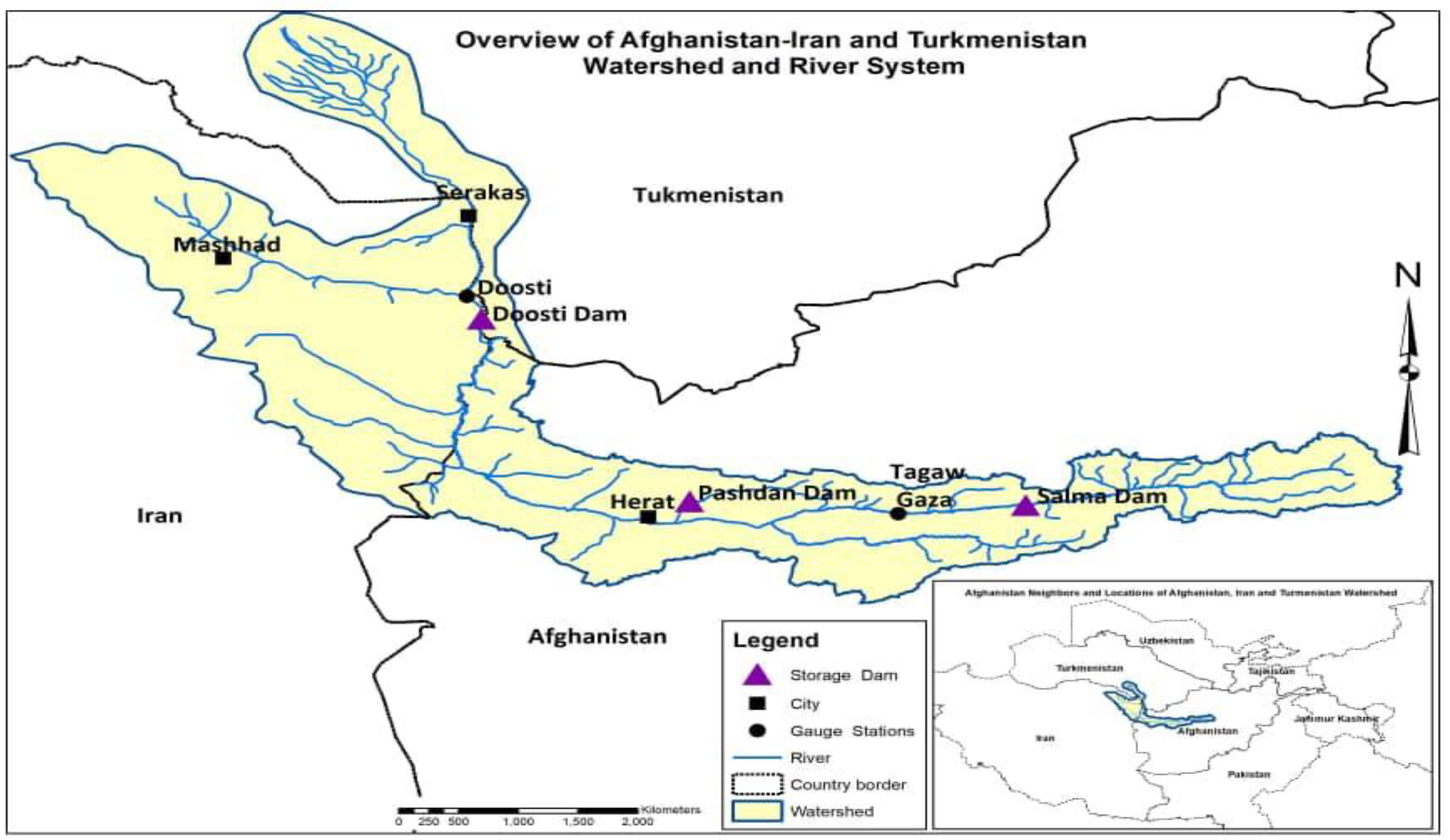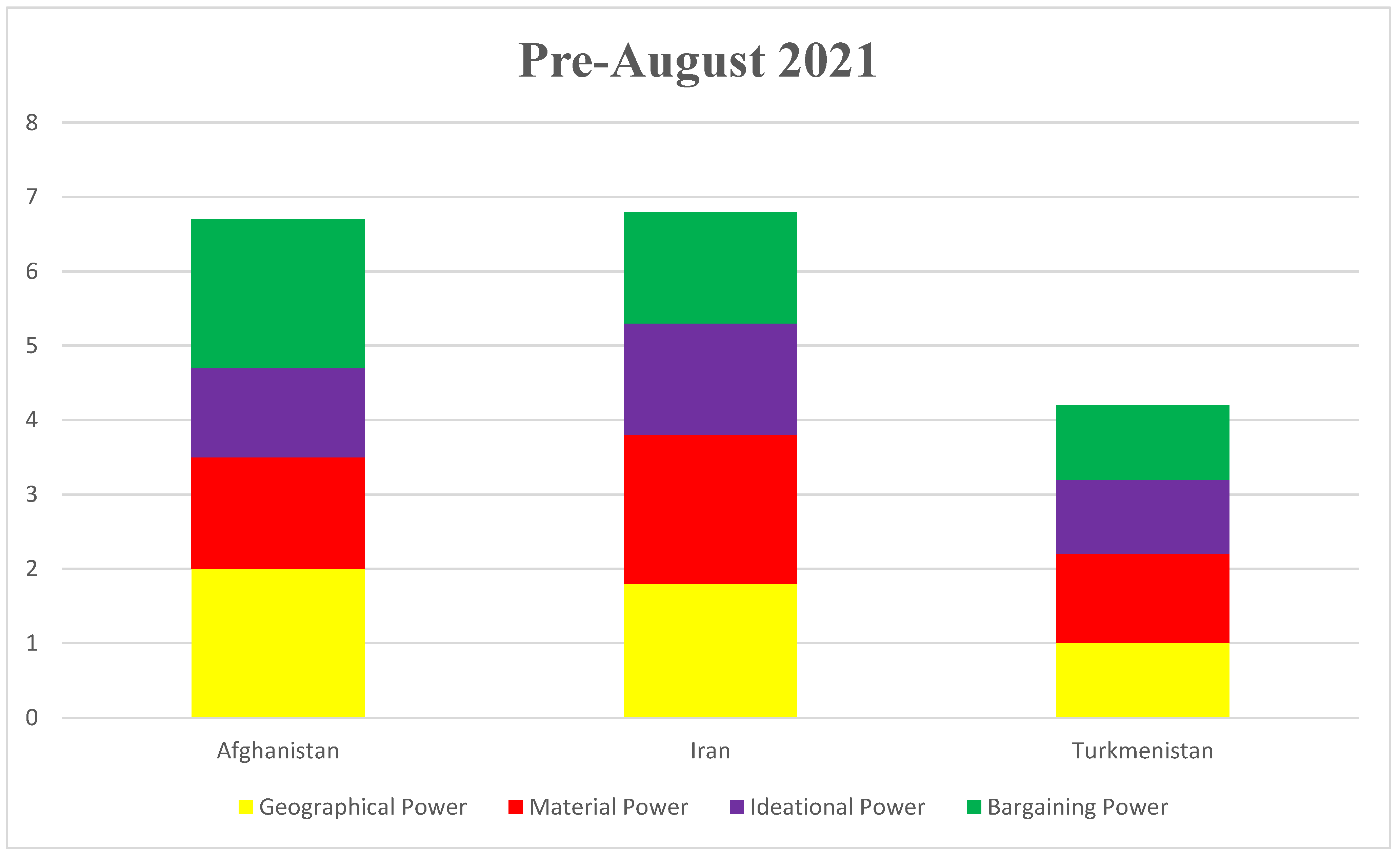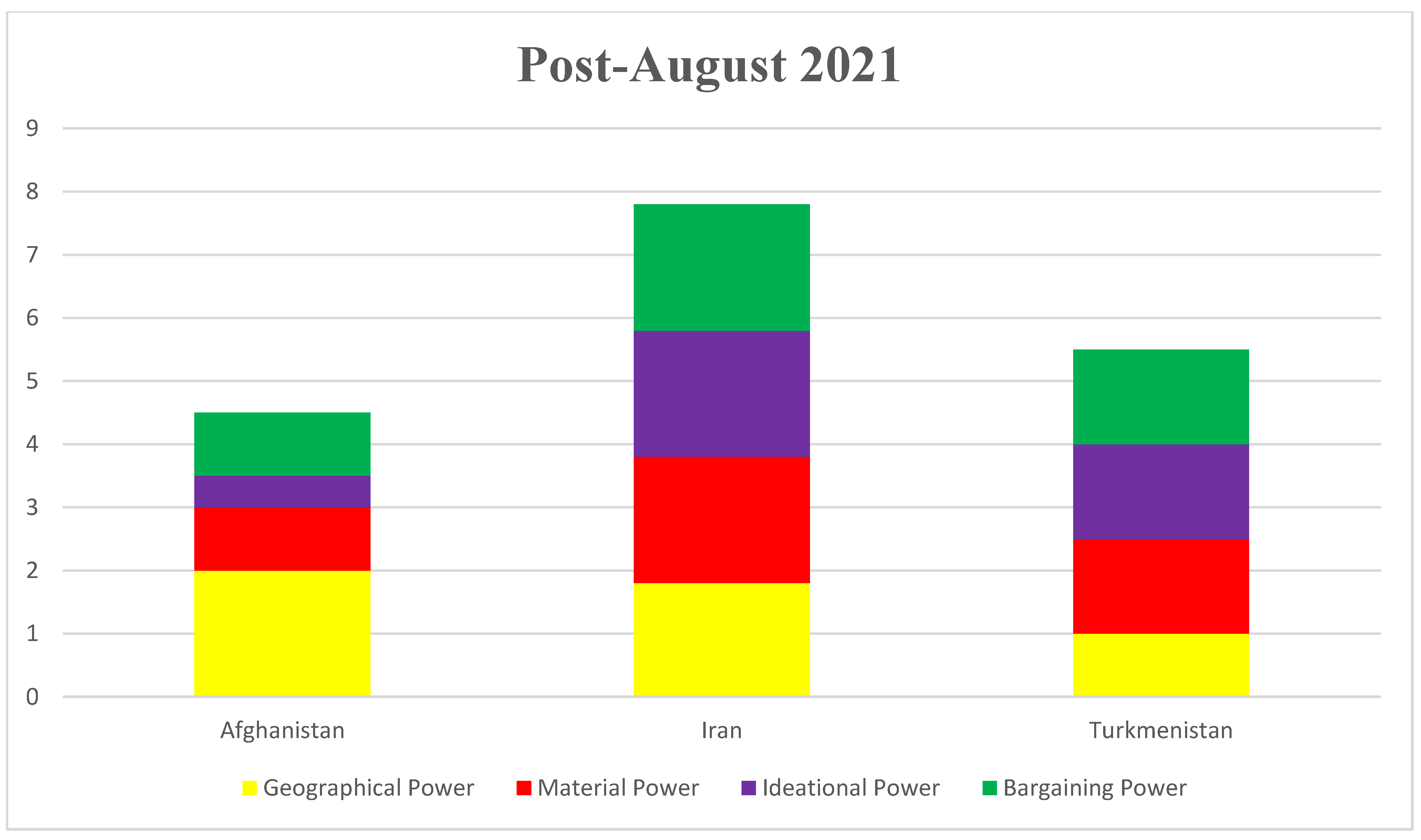A Review of Hydro-Hegemonic Dynamics on the Transboundary Harirud River Basin: 2001–Present
Abstract
:1. Introduction
1.1. Conceptual Framework: Hydro-Hegemony Framework
1.2. Construction of Dams on Upper Harirud River Basin
1.2.1. Salma Dam
1.2.2. Pashdan Dam
1.3. Construction of Dam on lower Harirud River Basin
Doosti Dam
1.4. Hydro-Hegemonic Dynamics in the Harirud River Basin
2. Method
2.1. Geographical Power
2.2. Material Power
2.3. Bargaining Power
2.4. Ideational Power
2.5. The Role of Basin-Outsiders in the Harirud River Basin
2.6. A Change in Hydro-Hegemonic Dynamic of Upstream State under Taliban Administration
3. Conclusions
Author Contributions
Funding
Data Availability Statement
Acknowledgments
Conflicts of Interest
References
- Shroder, J.F.; Ahmadzai, S.J. Transboundary Water Resources in Afghanistan: Climate Change and Land-Use Implications; Elsevier: Amsterdam, The Netherlands, 2016. [Google Scholar]
- Favre, R.; Kamal, G.M. Watershed Atlas of Afghanistan; Ministry of Irrigation: Kabul, Afghanistan, 2004. [Google Scholar]
- Goes, B.; Howarth, S.; Wardlaw, R.; Hancock, I.; Parajuli, U. Integrated water resources management in an insecure river basin: A case study of Helmand River Basin, Afghanistan. Int. J. Water Resour. Dev. 2015, 32, 3–25. [Google Scholar] [CrossRef]
- Kamran, H.; Yari, E.; Abedi, M. Environmental security and national security in the context of cross-border hydropolitics developments (case study: Harirud). Iran. J. Geogr. 2017, 15, 305–328. [Google Scholar]
- FAO. Irrigation in Central Asia in figures. In AQUASTAT Survey 2012; Water Reports 39; Frenken, K., Ed.; FAO: Rome, Italy, 2013; ISBN 978-92-5-106316-3. [Google Scholar]
- Nagheeby, M.; Warner, J. The geopolitical overlay of the hydropolitics of the Harirud River Basin. Int. Environ. Agreem. Politics Law Econ. 2018, 18, 839–860. [Google Scholar] [CrossRef] [Green Version]
- Parenti, C. America’s Jihad: A History of Origins. Soc. Justice 2001, 28, 31–38. Available online: http://www.jstor.org/stable/29768089 (accessed on 9 April 2022).
- Nagheeby, M.; Piri, D.M.; Faure, M. The Legitimacy of Dam Development in International Watercourses: A Case Study of the Harirud River Basin. Transnatl. Environ. Law 2019, 8, 247–278. [Google Scholar] [CrossRef] [Green Version]
- Thomas, V.; Varzi, M.M. A legal licence for an ecological disaster: The inadequacies of the 1973 Helmand/Hirmand water treaty for sustainable transboundary water resources development. Int. J. Water Resour. Dev. 2015, 31, 499–518. [Google Scholar] [CrossRef]
- Wadsam Newspaper. بند پاشدان هرات تا سال ۲۰۲۲ به بهرهبرداری سپرده میشود. 22 February 2020. Available online: https://dari.wadsam.com/band-pashdaan-herat-ta-saal-2022-ba-bahra-bardaari-supurda-meshawad-343/ (accessed on 12 March 2022).
- Thomas, V.; Warner, J. Hydropolitics in the Harirud/Tejen River Basin: Afghanistan as hydro-hegemon? Water Int. 2015, 40, 593–613. [Google Scholar] [CrossRef]
- Amini, A.; Jafari, H.; Malekmohammadi, B.; Nasrabadi, T. Transboundary Water Resources Conflict Analysis Using Graph Model for Conflict Resolution: A Case Study—Harirud River. Discret. Dyn. Nat. Soc. 2021, 2021, 1720517. [Google Scholar] [CrossRef]
- Amini, S. The U.S. Needs to Find the Middle Ground on Afghanistan. Foreign Policy. 7 July 2022. Available online: https://foreignpolicy.com/2022/07/07/united-states-afghanistan-taliban-international-support-engagement/ (accessed on 26 July 2022).
- Wester, P.; Rap, E.; Vargas-Velázquez, S. The hydraulic mission and the Mexican hydrocracy: Regulating and reforming the flows of water and power. Water Altern. 2009, 2, 395–415. [Google Scholar]
- Zeitoun, M.; Warner, J. Hydro-hegemony—A framework for analysis of trans-boundary water conflicts. Water Policy 2006, 8, 435–460. [Google Scholar] [CrossRef] [Green Version]
- Gearan, A.; Wootson, C.R. Defiant and Defensive, a President Known for Empathy Takes a Cold-Eyed Approach to Afghanistan Debacle. Washington Post. 16 August 2021. Available online: https://www.washingtonpost.com/politics/biden-afghanistan-pullout-defensive/2021/08/15/fbcda2d8-fdd4-11eb-ba7e-2cf966e88e93_story.html (accessed on 8 October 2022).
- Business Standard. 16 Security Personnel Killed in Taliban Attack near Afghanistan’s Salma Dam. Business-Standard. 6 July 2021. Available online: https://www.business-standard.com/article/international/16-security-personnel-killed-in-taliban-attack-near-afghanistan-s-salma-dam-121070600209_1.html (accessed on 15 February 2022).
- Julien, F. Hydropolitics is what societies make of it (or why we need a constructivist approach to the geopolitics of water). Int. J. Sustain. Soc. 2012, 4, 45. [Google Scholar] [CrossRef]
- Elhance, A.P. Conflict and cooperation over water in the Aral Sea basin. Stud. Confl. Terror. 1997, 20, 207–218. [Google Scholar] [CrossRef]
- Kraak, E. Diverging discourses on the Syr Darya. Geography Environ. Sustain. 2012, 5, 36–50. [Google Scholar]
- Hayat, S.; Gupta, J.; Vegelin, C.; Jamali, H. A review of hydro-hegemony and transboundary water governance. Water Policy 2022. [Google Scholar] [CrossRef]
- Daoudy, M. Hydro-hegemony and international water law: Laying claims to water rights. Water Policy 2008, 10, 89–102. [Google Scholar] [CrossRef] [Green Version]
- Conker, A.; Hussein, H. Hydropolitics and issue-linkage along the Orontes River Basin: An analysis of the Lebanon–Syria and Syria–Turkey hydropolitical relations. Int. Environ. Agreem. Politics Law Econ. 2020, 20, 103–121. [Google Scholar] [CrossRef] [Green Version]
- Warner, J.; Mirumachi, N.; Farnum, R.L.; Grandi, M.; Menga, F.; Zeitoun, M. Transboundary ‘hydro-hegemony’: 10 years later. Wiley Interdiscip. Rev. Water 2017, 4, e1242. [Google Scholar] [CrossRef] [Green Version]
- Naff, T.; Matson, R.C. Water in the Middle East: Conflict or Cooperation? Westview Press, 1984; Available online: https://www.taylorfrancis.com/books/mono/10.4324/9780429267284/water-middle-east-thomas-naff (accessed on 22 September 2022).
- Warner, J. Flood Planning; IB Tauris: London, UK, 2011. [Google Scholar]
- Nader, A.; Laha, J. Iran’s Balancing Act in Afghanistan (32). 2011. Available online: https://www.rand.org/pubs/occasional_papers/OP322.html (accessed on 22 February 2022).
- Aman, F. “Water Dispute Escalating between Iran and Afghanistan.” Water Dispute Escalating between Iran and Afghanistan. August 2016. Available online: www.atlanticcouncil.org/wpcontent/uploads/2016/09/Water_Dispute_Escalating_between_Iran_and_Afghanistan_web_0830.pdf (accessed on 25 February 2022).
- Ramachandran, S. India’s Controversial Afghanistan Dams. The Diplomat. 20 August 2018. Available online: https://thediplomat.com/2018/08/indias-controversial-afghanistan-dams/ (accessed on 12 August 2020).
- Omar. Pashdan Dam Construction Moves Ahead Despite Iranian Sabotage Efforts. 8 April 2020. Available online: https://afghanistan.asia-news.com/en_GB/articles/cnmi_st/features/2020/04/08/feature-02 (accessed on 12 May 2020).
- Jain, R. In Parched Afghanistan, Drought Sharpens Water Dispute with Iran. 17 July 2018. Available online: https://www.reuters.com/article/us-afghanistan-iran-water/in-parched-afghanistan-drought-sharpens-water-dispute-with-iran-idUSKBN1K702H (accessed on 4 August 2020).
- Farr, G. Afghan Refugees and the Coronavirus Pandemic. 26 May 2020. Available online: https://www.e-ir.info/2020/05/26/afghan-refugees-and-the-coronavirus-pandemic/ (accessed on 25 August 2020).
- Majidyar, A.; Alfoneh, A. Iranian Influence in Afghanistan: Refugees as Political Instruments. American Enterprise Institute for Public Policy Research. Middle Eastern Outlook, No. 5. November 2010. Available online: https://www.jstor.org/stable/pdf/resrep03100.pdf?refreqid=excelsior%3A5fcf1a65ddb2ba851e52c6ebbc3d38d1 (accessed on 13 December 2020).
- Frey, F.W. The Political Context of Conflict and Cooperation Over International River Basins. Water Int. 1993, 18, 54–68. [Google Scholar] [CrossRef]
- Gleick, P.H. Water in crisis: Paths to sustainable water use. Ecol. Appl. 1998, 8, 571–579. [Google Scholar] [CrossRef]
- Lowi, M.R. Bridging the Divide: Transboundary Resource Disputes and the Case of West Bank Water. Int. Secur. 1993, 18, 113. [Google Scholar] [CrossRef]
- Homer-Dixon, T.F. Environmental scarcity and violent conflict: Evidence from cases. Int. Secur. 1994, 19, 5–40. [Google Scholar] [CrossRef] [Green Version]
- Wolf, A.T. Conflict Prevention and Resolution in Water Systems; Edward Elgar Publishing Ltd.: Cheltenham, UK, 2002. [Google Scholar]
- Wolf, A.T. Regional Water Cooperation as Confidence Building: Water Management as a Strategy for Peace; Adelphi Research: Berlin, Germany, 2004. [Google Scholar]
- VOA. Water Is Considered as Our National Security. 10 May 2022. Available online: https://ir.voanews.com/a/qalibaf-water-national-security/6565429.html (accessed on 11 May 2022).
- Farnum, B. Contesting or Creating Hegemony? A Critique of the London Water Research Group Considering Academic Hegemony and Traps in Social Justice Research. 2014. Available online: https://www.uea.ac.uk/watersecurity/events/hh7/readings (accessed on 20 February 2022).
- Zinzani, A.; Menga, F. The Circle of Hydro-Hegemony between riparian states, development policies and borderlands: Evidence from the Talas waterscape (Kyrgyzstan-Kazakhstan). Geoforum 2017, 85, 112–121. [Google Scholar] [CrossRef] [Green Version]
- Furlong, K. Hidden theories, troubled waters: Response to critics. Political Geogr. 2008, 27, 811–814. [Google Scholar] [CrossRef]
- Menga, F. Reconceptualizing hegemony: The circle of hydro-hegemony. Water Policy 2016, 18, 401–418. [Google Scholar] [CrossRef]
- Kumar, R.; Prasad, N.; Mahure, V.; Sharma, P.; Gupta, L.; Ratnam, M. Concreting at Low Ambient Temperatures at Salma Dam Project Afghanistan—A Case Study. 2014. Available online: http://citeseerx.ist.psu.edu/viewdoc/download?doi=10.1.1.443.6233&rep=rep1&type=pdf (accessed on 26 September 2022).
- Karimi, S. 85% Construction Work of Pashdan Dam Completed: Qatali. Pajhwok Afghan News. 24 March 2021. Available online: https://pajhwok.com/2021/03/24/85pc-construction-work-of-pashdan-dam-completed-qatali/ (accessed on 22 October 2021).
- Omar. With Construction Halted, Herat’s Pashdan Dam Faces Uncertain Future. Salaam Times. 18 January 2022. Available online: https://afghanistan.asia-news.com/en_GB/articles/cnmi_st/features/2022/01/18/feature-01 (accessed on 4 August 2022).
- Mozafari, M.; Raeisi, E.; Zare, M. Water leakage paths in the Doosti Dam, Turkmenistan and Iran. Environ. Earth Sci. 2012, 65, 103–117. [Google Scholar] [CrossRef]
- Asian Development Bank. Hari Rud River Basin Master Plan. unpublished document. 2014. [Google Scholar]
- U.S. pushes to finish Afghan dam as challenges mount. USA Today. 6 January 2013. Available online: https://www.usatoday.com/story/news/world/2013/01/06/us-afghanistan-dam-kajaki/1811773/ (accessed on 10 August 2022).
- Ramachandran, S. Afghanistan Risks Water Conflict with Iran. 30 July 2016. Available online: https://cacianalyst.org/publications/analytical-articles/item/13379-afghanistan-risks-water-conflict-with-iran.html (accessed on 12 August 2020).
- Hessami, E.B. Afghanistan’s Water Plans Complicated by Worried Neighbors. Climate. 20 March 2017. Available online: https://climate-diplomacy.org/magazine/afghanistans-water-plans-complicated-worried-neighbors (accessed on 5 August 2022).
- Salehi, N.A. Salma Dam Underutilized Due to Lack of Irrigation Canals. TOLOnews. 30 March 2021. Available online: https://tolonews.com/business-171098 (accessed on 5 August 2022).
- Mohammadi, Z. Bazar: Concerns Raised over Salma Dam’s Water Level. TOLOnews. 10 April 2018. Available online: https://tolonews.com/business/bazar-concerns-raised-over-salma-dam%E2%80%99s-water-level (accessed on 5 August 2022).
- Madani, K. Water management in Iran: What is causing the looming crisis? J. Environ. Stud. Sci. 2014, 4, 315–328. [Google Scholar] [CrossRef]
- Madani, K.; AghaKouchak, A.; Mirchi, A. Iran’s Socio-economic Drought: Challenges of a Water-Bankrupt Nation. Iran. Stud. 2016, 49, 997–1016. [Google Scholar] [CrossRef]
- Madani, K.; Mahoozi, S. Kaveh Madani. DAWN. 4 January 2022. Available online: https://dawnmena.org/author/kaveh-madani/ (accessed on 17 April 2022).
- AghaKouchak, A.; Norouzi, H.; Madani, K.; Mirchi, A.; Azarderakhsh, M.; Nazemi, A.; Nasrollahi, N.; Farahmand, A.; Mehran, A.; Hasanzadeh, E. Aral Sea syndrome desiccates Lake Urmia: Call for action. J. Great Lakes Res. 2015, 41, 307–311. [Google Scholar] [CrossRef]
- Madani, K. Explainer: Iran’s “Water Bankruptcy”. The Iran Primer. 5 December 2021. Available online: https://iranprimer.usip.org/blog/2021/dec/05/explainer-irans-water-bankruptcy (accessed on 24 April 2022).
- Iqbal, M.W.; Donjadee, S.; Kwanyuen, B.; Liu, S.-Y. Farmers’ perceptions of and adaptations to drought in Herat Province, Afghanistan. J. Mt. Sci. 2018, 15, 1741–1756. [Google Scholar] [CrossRef]
- Mayar, M.A. The Climate Change Crisis in Afghanistan: The Catastrophe Worsens—What Hope for Action? Afghanistan Analysts Network—English. 28 June 2022. Available online: https://www.afghanistan-analysts.org/en/reports/economy-development-environment/the-climate-change-crisis-in-afghanistan-the-catastrophe-worsens-what-hope-for-action/ (accessed on 10 August 2022).
- Hussaini, S.A.; Azimi, A.B. Statute for Illegal Water Rights, Helmand River Treaty Is the Only Water Treaty. 8 a.m. Newspaper Afghanistan. 6 February 2021. Available online: https://8am.af/articles-of-association-for-unfounded-payments-only-the-helmand-treaty-is-the-basis/ (accessed on 27 March 2022).
- Sinaei, V. Hydropolitics and Human Security: Water Cooperation in Relations between Iran, Afghanistan and Turkmenistan. Iranian Review of Foreign Affairs. 2011. Available online: https://profdoc.um.ac.ir/articles/a/1027822.pdf (accessed on 18 December 2021).
- Ghandhary, A.; Moghadam, S.A.; Khorasani, H.O. Predicting the necessity of cooperation between the Harirud basin countries based on game theory: The shapely value approach. J. Water Sustain. Dev. 2016, 3, 115–121. [Google Scholar]
- Ruwitch, J. Afghanistan’s Economy Has Worsened Since the Taliban Took Power. NPR. 29 September 2021. Available online: https://www.npr.org/2021/09/29/1041625317/afghanistans-economy-has-worsened-since-the-taliban-took-power (accessed on 29 September 2022).
- Benjamin, P.; Bozorgmehr, N. Afghanistan Confronts Economic Meltdown after Taliban Takeover. Subscribe to Read | Financial Times, Financial Times. 31 August 2021. Available online: https://www.ft.com/content/504db1d2-239f-4388-a4db-4e9cd155d312 (accessed on 28 September 2022).
- Daoudy, M. The Origins of the Syrian Conflict: Climate Change and Human Security; Cambridge University Press: Cambridge, UK, 2020. [Google Scholar]
- Hussein, H. Whose ‘reality’? Discourses and hydropolitics along the Yarmouk River. Contemp. Levant 2017, 2, 103–115. [Google Scholar] [CrossRef] [Green Version]
- Allouche, J. Nationalism, legitimacy, and hegemony in transboundary water interactions. Water Altern. 2020, 13, 286–301. [Google Scholar]
- VOA Dari, P. فرار ‘مغزها’ از افغانستان فرار ‘قرن ۲۱ از این کشور’ است-تحلیلگران. صدای امریکا. 20 July 2022. Available online: https://www.darivoa.com/a/brains-drain-from-afghanistan-is-21st-century-escape-from-the-country-say-analysts/6663998.html (accessed on 7 August 2022).
- Amin, M. Perspective | Americans Nurtured Afghanistan’s Economy. Now They’re Gutting it. The Washington Post. 18 February 2022. Available online: https://www.washingtonpost.com/outlook/2022/02/18/afghanistan-bank-frozen-assets/ (accessed on 24 October 2022).
- Shroder, J. Hydro-Hegemony in Afghanistan and Surrounding Countries. Transboundary Water Resources in Afghanistan; Elsevier: Amsterdam, The Netherlands, 2016; pp. 339–359. [Google Scholar]
- Hasrat, A.S. Freeze on Afghanistan’s Assets Slammed as Unfair. Pajhwok Afghan News Afghan Tag. 27 September 2021. Available online: https://pajhwok.com/tag/afghan/ (accessed on 22 September 2022).
- Varshalomidze, T.; Siddiqui, U.; Regencia, T. Biden Keeps to August 31 Deadline for Kabul Airlift. Taliban News | Al Jazeera. 26 August 2021. Available online: https://www.aljazeera.com/news/2021/8/24/g7-to-meet-on-afghanistan-withdrawal-deadline-live-news (accessed on 20 January 2022).
- Mohamed, H.; Allahoum, R. Taliban Sweeps through Afghan Capital as President Flees. Taliban News | Al Jazeera. 16 August 2021. Available online: https://www.aljazeera.com/news/2021/8/15/taliban-continues-advances-captures-key-city-of-jalalabad (accessed on 13 May 2022).
- Brooking, E.T. Before the Taliban Took Afghanistan, It Took the Internet. Atlantic Council. 26 August 2021. Available online: www.atlanticcouncil.org/blogs/new-atlanticist/before-the-taliban-took-afghanistan-it-took-the-internet/ (accessed on 6 September 2022).
- Molle, F.; Mollinga, P.P.; Wester, P. Hydraulic bureaucracies and the hydraulic mission: Flows of water, flows of power. Water Altern. 2009, 2, 328–349. [Google Scholar]
- Smith, D.L. Central Asia: A new Great Game? Asian Aff. Am. Rev. 1996, 23, 147–175. [Google Scholar] [CrossRef]
- Cullather, N. Damming Afghanistan: Modernization in a Buffer State. J. Am. Hist. 2002, 89, 512–537. [Google Scholar] [CrossRef]
- Hessami, E. Afghanistan’s Rivers Could Be India’s Next Weapon against Pakistan. 13 November 2018. Available online: https://foreignpolicy.com/2018/11/13/afghanistans-rivers-could-be-indias-next-weapon-against-pakistan-water-wars-hydropower-hydrodiplomacy/ (accessed on 20 September 2022).
- BBC. What Is Sharia Law? What Does It Mean for Women in Afghanistan? BBC News. 19 August 2021. Available online: www.bbc.com/news/world-27307249 (accessed on 10 October 2022).
- Loodin, N.; Wolf, A.T. Will Islamic Water Management Principles Be Included If the Helmand River Treaty Is Revisited? Water 2022, 14, 67. [Google Scholar] [CrossRef]
- Wolf, A.T. Indigenous Approaches to Water Conflict Negotiations and Implications for International Waters. Int. Negot. 2000, 5, 357–373. [Google Scholar] [CrossRef]
- Jaafari, S. The Taliban Want International Recognition: Countries Are Debating. The World from PRX. 17 September 2021. Available online: https://www.pri.org/stories/2021-09-17/taliban-want-international-recognition-countries-are-debating (accessed on 15 March 2022).
- Karimi, N.; Rahim, F. Iran Hosts High-Level Afghan Peace Talks as Fighting SURGES. Military.com. 8 July 2021. Available online: www.military.com/daily-news/2021/07/08/iran-hosts-high-level-afghan-peace-talks-fighting-surges.html (accessed on 5 October 2022).
- Ali, A. The Taliban Have Reportedly Promised to Supply Water to Iran in Return for Support (د راپورونو له مخې طالبانو د ملاتړ په بدل کې ایران ته د اوبو ورکولو ژمنه کړې ده). Afghanistan Asia News, Salaam Times. 25 February 2021. Available online: afghanistan.asia-news.com/ps/articles/cnmi_st/features/2021/02/25/feature-01 (accessed on 12 October 2022).
- Azimi, B. آب باید از «سند جامع راهبردی همکاری میان افغانستان و ایران» حذف شود. 20 July 2020. Available online: https://8am.af/water-should-be-removed-from-the-comprehensive-strategic-partnership-document-between-afghanistan-and-iran/ (accessed on 21 July 2020).
- Hussaini, S.A.; Azimi, A.B. Where Is the Water of Hamuns. 8 a.m. Newspaper Afghanistan. 23 March 2021. Available online: https://8am.af/where-is-the-water-of-hamuns/ (accessed on 28 March 2022).
- Osmani, A.A. Afghanistan’s Water Resources Are in the Grip of Iran’s Reverse Cycle. 8 a.m. Newspaper Afghanistan. 9 April 2021. Available online: https://8am.af/afghanistans-water-resources-are-in-the-grip-of-irans-reverse-cycle/ (accessed on 27 March 2022).
- Al-Monitor, A. Iran Confirms Taliban Diplomats Stationed in Tehran Embassy. Al. 26 April 2022. Available online: https://www.al-monitor.com/originals/2022/04/iran-confirms-tmban-diplomats-stationed-tehran-embassy (accessed on 29 April 2022).
- Takal, K.M. ایران او ګانډیان نه قانع کیږي! Twitter. 20 January 2022. Available online: https://twitter.com/Khan_Takal/status/1484194170675904513?s=20&t=hBOUVl0020CULyYS9u5tMA (accessed on 17 August 2022).
- Asim, G.M.; Ando, T. A study on cisterns in the Herat old city, Afghanistan. J. Arch. Plan. (Trans. AIJ) 2020, 85, 781–789. [Google Scholar] [CrossRef]



| Pre-August 2021 | ||||
|---|---|---|---|---|
| Number | Pillars of Hydro-Hegemony | Riparian States of Harirud River Basin | ||
| Upstream Riparian | Downstream Riparians | |||
| Afghanistan | Iran | Turkmenistan | ||
| 1 | Geographical Power | 2 | 1.8 | 1 |
| 2 | Material Power | 1.5 | 2 | 1.2 |
| 3 | Ideational Power | 1.2 | 1.5 | 1 |
| 4 | Bargaining Power | 2 | 1.5 | 1 |
| Post-August 2021 | ||||
|---|---|---|---|---|
| Number | Pillars of Hydro-Hegemony | Riparian States of Harirud River Basin | ||
| Upstream Riparian | Downstream Riparians | |||
| Afghanistan | Iran | Turkmenistan | ||
| 1 | Geographical Power | 2 | 1.8 | 1 |
| 2 | Material Power | 1 | 2 | 1.5 |
| 3 | Ideational Power | 0.5 | 2 | 1.5 |
| 4 | Bargaining Power | 1 | 2 | 1.5 |
Publisher’s Note: MDPI stays neutral with regard to jurisdictional claims in published maps and institutional affiliations. |
© 2022 by the authors. Licensee MDPI, Basel, Switzerland. This article is an open access article distributed under the terms and conditions of the Creative Commons Attribution (CC BY) license (https://creativecommons.org/licenses/by/4.0/).
Share and Cite
Loodin, N.; Warner, J. A Review of Hydro-Hegemonic Dynamics on the Transboundary Harirud River Basin: 2001–Present. Water 2022, 14, 3442. https://doi.org/10.3390/w14213442
Loodin N, Warner J. A Review of Hydro-Hegemonic Dynamics on the Transboundary Harirud River Basin: 2001–Present. Water. 2022; 14(21):3442. https://doi.org/10.3390/w14213442
Chicago/Turabian StyleLoodin, Najibullah, and Jeroen Warner. 2022. "A Review of Hydro-Hegemonic Dynamics on the Transboundary Harirud River Basin: 2001–Present" Water 14, no. 21: 3442. https://doi.org/10.3390/w14213442
APA StyleLoodin, N., & Warner, J. (2022). A Review of Hydro-Hegemonic Dynamics on the Transboundary Harirud River Basin: 2001–Present. Water, 14(21), 3442. https://doi.org/10.3390/w14213442







